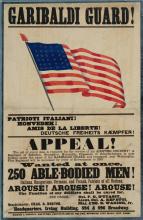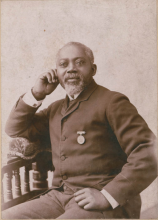Infusing Disability History into the Classroom
Published on Wed, 10/02/2024
Insights on Multilingual Learners from History and Social Studies Teachers
Published on Tue, 04/30/2024
Guest post by Jacqueline LaFrance
Online Exhibit on Impacts of the Civil War on Disability
Published on Tue, 10/17/2023
Explore the compelling stories of Civil War nurses and disabled veterans.
How did their experiences change America?
Visit the new online exhibit: How Civil War Veterans Transformed Disability.
What is our value? A look at undervalued people
Putting Primary Sources in Order - Text Set and Flow Map
Organizing a rich text set of primary sources requires that students analyze and make sense of several sources on a topic. In this case, they seek to answer a focused guiding question. Students sort through about a dozen images, letters, forms, and political cartoon. In practice, a teacher could offer fewer sources, though it is a valuable sometimes to require students to choose among sources. The primary sources are also give context by a secondary source narrative from the Veterans Administration.
History eNews from Emerging America - April 8, 2020
Published on Wed, 04/08/2020
EMERGING AMERICA HISTORY eNEWS Vol. 7, Issue 12 for April 8, 2020
Road to Freedom: Emancipation Proclamation
Since arriving in North America in the 15th century, Africans in the United States were forced to navigate the social, economic, and physical limitations placed upon their lives by the institutions of slavery and the racist ideology that justified it. The following primary source set shows several ways that different communities responded to the outlawing of the Atlantic slave trade (and subsequent yearly celebrations of the event) and the Emancipation Proclamation. These two events fundamentally challenged and changed the institutional practices of slavery.
The Fugitive Slave Act: No Turning Back!
The Fugitive Slave Act of 1850 allowed for the capture and return of runaway slaves. Northerner legislatures passed laws in an attempt to reduce the impact of the FSA and how the work of the Underground Railroad (UGRR) was impacted. Students will learn how the Fugitive Slave Act of 1850 (FSA) changed perspectives of Northerners and the ultimate destination of the fugitives themselves. Students will learn background knowledge and vocabulary about the Underground Railroad in the United States.
Civil War and Reconstruction
The Library of Congress holds the best collection of primary sources anywhere on the Civil War and Reconstruction. (See especially the exhibitions under “d” below.) Therefore, the great challenge is to choose the most significant yet engaging and classroom-friendly from among hundreds of thousands of photos, drawings, newspaper articles, speeches, maps, and songs. Each item in this set focuses on a vital point in the conflict and its aftermath. Each item offers clear and meaningful opportunity for students to dig deeper.




